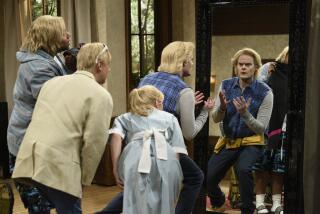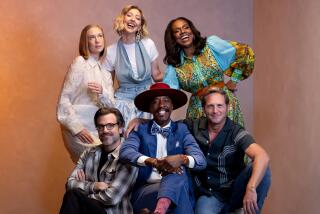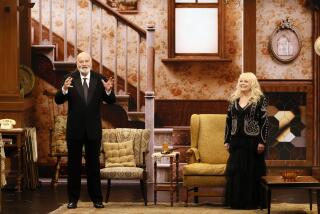Charles Douglass, 93; Inventor Brought Canned Laughs to TV
- Share via
Charles Rolland Douglass, who invented the TV laugh-track technology that either (a) allowed television to preserve a crucial comedic tradition or (b) condemned the sitcom to an atmosphere of artificiality, has died at 93.
Douglass, who won an Emmy for his achievement, did not give interviews because he did not want to wind up in the middle of the debate, a close associate said Thursday.
“He took an awful lot of flak for that,” said Carroll Pratt, a recording engineer who worked with Douglass for 30 years. “Some of it should have been pointed at the nervous producers and directors, but he was the recipient.”
Douglass, who died April 8 at a hospital in Templeton, Calif., after contracting pneumonia, invented the Laff Box -- essentially a series of audiotape loops that could be controlled by a sound editor.
Originally, the device was intended to simply fill in the sound holes of early ‘50s TV shows that re-shot scenes after the studio audience had gone home. But its use was soon expanded to exaggerate -- or “sweeten” -- existing laughter and to provide full-scale laughter for shows shot without a studio audience.
Ultimately, the Laff Box featured hundreds of human sounds that allowed the operator to play an instrument in which the “audience” first murmured, then guffawed, then exploded with laughter.
According to television lore, the original laughs and applause for the machine were stripped from an episode of “The Red Skelton Show,” said Ron Simon, a curator at the Museum of Television & Radio in New York. That show was picked because Skelton was performing in pantomime, providing a dialogue-free recording. Over the years, Douglass added more sounds.
Though it has been in existence for half a century, the Laff Box has generated scorn as well as gratitude from TV producers and writers.
It helps provide needed guffaws and pacing when multiple takes at sitcom tapings have wrung the last laughs out of tired audiences.
But the laugh track has been the “bane of certain elements of the creative community for many years,” said Tim Brooks, co-author of “The Complete Directory of Prime-Time Network and Cable TV Shows.”
“Many feel that it degrades its art somehow,” Brooks said. “What happened is, TV is renowned for excess. It seems to be unable to constrain itself.” In the 1960s and ‘70s, he said, “some producers went crazy with laugh tracks and turned them higher and higher” so that people would consider a show funny “even when it wasn’t.”
Robert Thompson, a Syracuse University professor who specializes in the study of television and popular culture, said critics of the laugh track overlook that it is simply preserving the communal tradition of American humor.
“So much of the rhythm, the syntax, the grammar of comedy depends on the pauses supplied by people laughing,” Thompson said.
Most radio comedies, such as “The Jack Benny Show,” “Burns and Allen” and “The Fred Allen Show,” featured the laughter of live audiences.
But in the early days of TV, when filming and taping began, “It immediately became apparent that, if you used the same type of comic style, and nobody laughed, you were dying up there,” Thompson said.
The omnipresence of canned laughter diminished a bit in the 1970s and ‘80s, when powerful producers successfully fought to keep their shows laugh-track free, most notably Jay Tarses (“The Days and Nights of Molly Dodd”) and Larry Gelbart (certain episodes of “MASH”).
Today, several popular sitcoms not filmed in front of a studio audience -- from Fox’s “Malcolm in the Middle” and “Bernie Mac” to HBO’s “Sex and the City” -- forgo laugh tracks.
Even the currently longest-running comedy series, Fox’s “The Simpsons,” has no laugh track. (Forty years earlier, though, ABC’s animated primetime comedy series “The Flintstones” did use the Laff Box.)
These shows notwithstanding, the majority of sitcoms still rely on prerecorded responses. Before agreeing to bring the struggling sitcom “Watching Ellie” back for a second season, NBC insisted that it now include a laugh track.
Douglass, a former CBS radio engineer, was working as a technical director for many live television shows in the early 1950s. It was around 1953 when he came up with a laugh machine for TV.
“The producers wanted the live feeling that there was an audience there, in some cases,” said Leo Chaloukian, who owned Ryder Sound Service and is now treasurer of the Academy of Television Arts & Sciences.
“The track tried to preserve the quality that was always part of radio and television,” said Simon, of the Museum of Television & Radio. “It was one way the audience at home could be connected to a performance.... It created the presence.”
Though now digitalized and the size of a laptop computer, the Laff Box was originally more than two feet high.
“We used to refer to it as a ‘typewriter’ because that is exactly what it looked like,” Chaloukian recalled.
Douglass would attend mixing sessions at Ryder Sound Service with his device. “We would hook him into the system and Charlie would put in the laughs or applause,” Chaloukian said.
Carroll Pratt was a re-recording mixer at MGM when he met Douglass in the early ‘50s. When Douglass’ business grew beyond his capacity to manage it, he asked Pratt to join him and the two worked 80- to 100-hour weeks because the new process was so popular among producers. They eventually expanded it to sweetening live music albums.
Pratt, who said he had a lighter touch than Douglass’, said that Douglass resisted overusing laughter, but that some producers wanted more.
“Charlie was such an affable guy, so willing to please producers who didn’t want my ‘lighter touch.’ They wanted Charlie because he’d go along with it,” Pratt said. “He was always such a sweet, unshakeable guy.”
The two shared a lot of uncanned laughs between themselves while working on the shows.
“In order to cue yourself, all of us had to sort of grab the joke, and because there was a reaction time between the brain and finger, we had to laugh to cue ourselves,” Pratt said. “So we laughed all the time.”
“He was always in good humor with the people he worked with,” echoed son Bob Douglass, who took over his father’s business, Northridge Electronics, when he retired in 1980. “He worked hard and endlessly.”
His father, he said, created the machine for technical reasons. “He didn’t realize how it would change the face of comedy.”
The machine, Bob Douglass said, helps with the pacing on single-camera comedy shows.
“They actually tested sitcoms during one night, two or three with the laugh track and one without,” he said. “And the one without didn’t do as well because people come to expect it. There was a feeling that something was missing.”
Douglass was born in 1910 in Guadalajara, Mexico. He and his parents left the country when he was 2 because of political unrest. The family moved to Nevada, where his father, a pioneering electrical engineer, worked in Tonopah’s silver mines.
Douglass worked his way through the University of Nevada during the Depression, earning a degree in electrical engineering in 1933. He moved to Los Angeles, where he first worked as a broadcast engineer for CBS Radio.
He also served in the Navy during World War II, working in Washington, D.C., on developing shipboard radar systems. After the war, he remained in the Naval Reserve, where he attained the rank of commander.
Douglass won his Emmy in 1992 for technical excellence for his invention of his audience-reaction machine.
He is survived of his wife of 62 years, Dorothy; sons Bob and Steve; a brother; and two grandchildren. A memorial service was held Saturday in Laguna Beach.
More to Read
The complete guide to home viewing
Get Screen Gab for everything about the TV shows and streaming movies everyone’s talking about.
You may occasionally receive promotional content from the Los Angeles Times.







